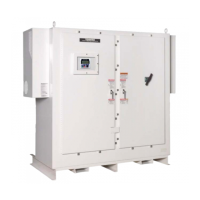10 HX7+ ASD Installation and Operation Manual
Operational and Maintenance
Precautions
• Turn off and lock-out/tag-out the main power, the control power, and instrumentation connections
before performing any of the following:
inspecting or servicing the ASD,
removing any enclosure panels, or
connecting/disconnecting the power wiring to the equipment.
• If/when taking a live reading (equipment is powered) is required, it shall to be performed by
Qualified Personnel ONLY. Proper and approved personal protection equipment is to be used by
the trained personnel for all electrical measurements.
• The capacitors of the ASD maintain a residual charge for a period of time after the ASD is powered
off. The required time for each ASD typeform is indicated with a cabinet label and a Charge
Indicator LED (see
Figure 4 on pg. 24). Wait at least the minimum time indicated on the
enclosure-mounted label and ensure that the Charge Indicator LED has gone out once the ASD
power has been turned off before coming into contact with any circuits.
Qualified Personnel shall
verify that the system capacitors have completely discharged.
• Turn the power on only after attaching (or closing) the front cover during normal operation. During
normal operation DO NOT open or remove the front cover or any of the enclosure panels of the
ASD when the power is on.
• DO NOT attempt to disassemble, modify, or repair the ASD. Contact your Toshiba Customer
Support Center for repair information.
• DO NOT place any objects inside of the ASD — this includes food or liquids.
• If the ASD should emit smoke, or an unusual odor or sound, turn off the power immediately.
• The heat sink and other components may become extremely hot to the touch. Allow the unit to cool
before coming in contact with these items.
•The Auto-Restart and Retry programmable functions of the ASD may allow for the system to
start or stop unexpectedly. Warning signs to this effect must be clearly posted at or near the
machinery/hazard.
• Remove power from the ASD during extended periods of non-use.
• Inspect the system annually (as a minimum) for damaged or improperly functioning parts,
cleanliness, and to ensure that the connectors are tightened securely. Inspect more frequently when
operating in a harsh environment or when used on a high-output-demand application.

